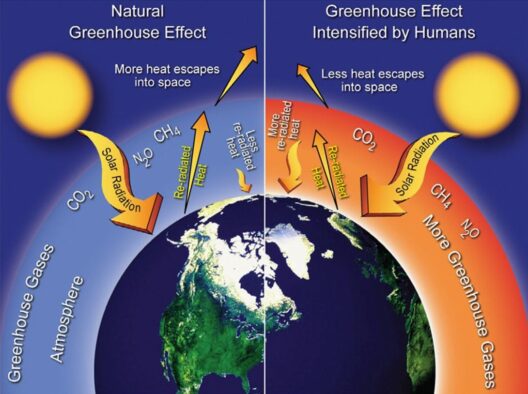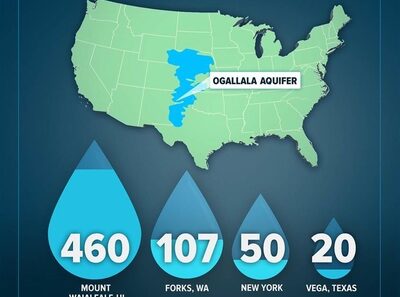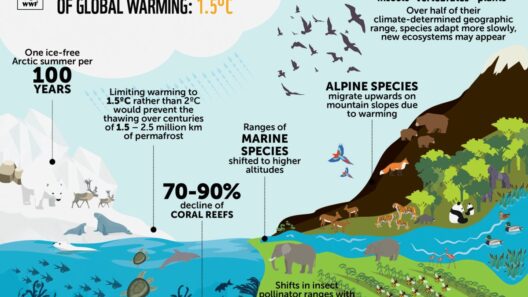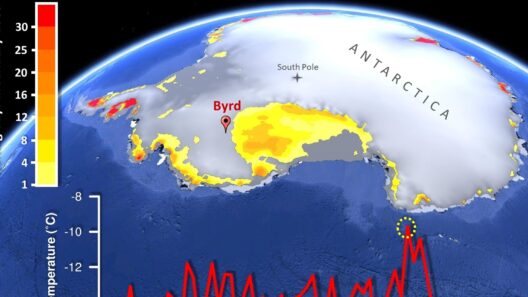Climate change is one of the most pressing issues confronting humanity, and its most visceral impacts are often most pronounced at the polar regions. The North and South Poles serve as critical indicators of environmental health, where the consequences of global warming are evidenced in real-time. This dynamic is not merely academic; it influences global weather patterns, sea levels, and even biodiversity across the planet. Understanding the implications of climate change at these poles sheds light on the urgent necessity for collective action.
Polar Regions: An Overview
The North Pole, situated in the Arctic Ocean, is often characterized by its floating sea ice. This ice undergoes seasonal thawing and refreezing, but recent decades have shown a alarming trend of diminishing ice during the warmer months. Conversely, the South Pole, home to the Antarctic continent, is predominantly covered by a thick ice sheet, which is the largest single mass of ice on Earth. While both poles experience similar climatic shifts, the type and magnitude of change differ significantly, impacting ecosystems on a grand scale.
The Current State of Polar Ice
Recent data reveals that Arctic sea ice is declining at a rate of approximately 13% per decade, with the summer ice extent shrinking even more dramatically. The consequences of this reduction extend far beyond the poles themselves. As ice melts, the dark ocean water is exposed, absorbing more sunlight and exacerbating warming—a phenomenon known as the albedo effect. This cycle of warming and melting is a harbinger for rising sea levels, which pose a significant risk to coastal communities across the globe.
In contrast, while the Antarctic ice sheet appears more stable, it too faces serious challenges. In West Antarctica, ice shelves are thinning and retreating, leading some scientists to hypothesize that a tipping point may be imminent. If significant portions of the Antarctic ice sheet were to collapse, the ramifications could be catastrophic; projections suggest potential sea-level rise of several meters, endangering millions.
Impact on Global Weather Patterns
The polar regions play an integral role in regulating global weather systems. With the growing instability of polar ice, researchers have observed alterations in atmospheric jet streams and ocean currents. These changes can lead to extreme weather events, including prolonged droughts, severe storms, and sudden temperature fluctuations in regions far removed from the poles. Such phenomena underscore the interconnectedness of Earth’s climate system and highlight how changes in one area can reverberate globally.
Furthermore, melting polar ice influences the distribution of heat in the ocean, as freshwater influx from melting glaciers disrupts established currents. This can modify marine ecosystems and the migratory patterns of various species, transforming biodiversity within marine environments.
Wildlife and Habitat Disruption
The loss of polar habitats due to climate change poses dire threats to wildlife. In the Arctic, species such as polar bears, seals, and walruses rely on sea ice for their survival. As these platforms diminish, fauna that depend on this habitat for hunting, breeding, and resting face peril. Polar bears, in particular, are often viewed as a flagship species for climate change; their declining populations serve as a stark indication of broader ecological distress.
Similarly, the Antarctic ecosystems are experiencing shifts. Adélie and emperor penguins, essential indicators of Antarctic health, depend on sea ice for breeding. As temperatures rise, significant portions of their habitat are disappearing, leading to declining populations and altering interactions among species within these fragile ecosystems.
Indigenous Communities and Cultural Heritage
The impact of climate change is not only biological but socio-cultural as well. Indigenous communities residing in the Arctic have lived harmoniously with their environment for millennia, relying on traditional knowledge and practices adapted to a stable climate. However, as climate patterns become increasingly erratic, these communities face a loss of food security, displacement, and a severed connection to their cultural heritage. The melting ice fundamentally alters not only their physical surroundings but also their way of life, creating a cultural dissonance that is difficult to navigate.
Future Projections and Mitigation Strategies
Extrapolating current trends, scientists caution that if greenhouse gas emissions continue unabated, critical thresholds could be breached, leading to irreversible changes. Global initiatives targeting emissions reduction, transitioning to renewable energy sources, and investing in sustainable practices are paramount if we hope to protect polar regions and, by extension, the planet.
Conservation efforts must be multifaceted, involving international cooperation to establish marine protected areas and create frameworks that promote resilience against climate fluctuations. Education, advocacy, and engagement with local communities can further empower environmental stewardship and foster a collective responsibility toward mitigating climate change.
Conclusion
The North and South Poles represent the epicenter of climate change, and as such, they require urgent attention and action. The melting ice serves as both a warning and a call to action—a powerful reminder that the decisions made today will reverberate through future generations. Protecting these regions is not only vital for sustaining the unique ecosystems they harbor; it is essential for maintaining global climate stability. As stewards of this planet, it falls upon humanity to act decisively and solicitously for the sake of our shared home.








